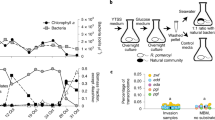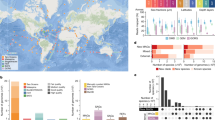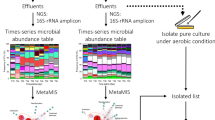Abstract
Growing attention in aquatic ecology is focusing on biogeographic patterns in microorganisms and whether these potential patterns can be explained within the framework of general ecology. The long-standing microbiologist’s credo ‘Everything is everywhere, but, the environment selects’ suggests that dispersal is not limiting for microbes, but that the environment is the primary determining factor in microbial community composition. Advances in molecular techniques have provided new evidence that biogeographic patterns exist in microbes and that dispersal limitation may actually have an important role, yet more recent study using extremely deep sequencing predicts that indeed everything is everywhere. Using a long-term field study of the ‘invasive’ marine haptophyte Prymnesium parvum, we characterize the environmental niche of P. parvum in a subtropical impoundment in the southern United States. Our analysis contributes to a growing body of evidence that indicates a primary role for environmental conditions, but not dispersal, in the lake-wide abundances and seasonal bloom patterns in this globally important microbe.
Similar content being viewed by others
Log in or create a free account to read this content
Gain free access to this article, as well as selected content from this journal and more on nature.com
or
References
American Public Health Association. (1998) Standard Methods for the Examination of Water and Waste Water 20th edn. American Public Health Association: Washington, DC, USA.
Army Corps of Engineers–Tulsa District. (2012). DSNT2: Lake Texoma, Denison Dam 2009. Available at http://www.swt-wc.usace.army.mil/DENI.lakepage.html Last accessed 14 July 2012.
Baas-Becking LGM . (1934) Geobiologie of inleiding tot de melieukunde. WP Van Stockum & Zoon: The Hague, The Netherlands.
Baker JW, Grover JP, Brooks BW, Urena-Boeck F, Roelke DL, Errera R et al. (2007). Growth and toxicity of Prymnesium parvum (Haptophyta) as a function of salinity, light, and temperature. J Phycol 43: 219–227.
Baker JW, Grover JP, Ramachandrannair R, Black C, Valenti TW, Brooks BW et al. (2009). Growth at the edge of the niche: an experimental study of the harmful alga Prymnesium parvum. Limnol Oceanogr 54: 1679–1687.
Burnham KP, Anderson DR . (2002) Model Selection and Multimodel Inference: A Practical Information–Theoretic Approach. Springer: Berlin, Germany.
Caron DA, Countway PD . (2009). The protistan Rare Biosphere in aquatic microbial ecology: hypotheses on the role of diversity in a changing world. Aquat Microb Ecol 57: 227–238.
Cichewicz RH, Hambright KD . (2010). A revised amino group pKa for prymnesins does not provide decisive evidence for a pH-dependent mechanism of Prymnesium parvum's toxicity. Toxicon 55: 1035–1037.
Davis CE, Hyde JE, Bangdiwala SI, Nelson JJ . (1986). An example of dependencies among variables in a conditional logistic regression. In: Moolgavkar SH, Prentice RL (eds) Modern Statistical Methods in Chronic Disease Epidemiology. Wiley: New York, NY, USA.
de Wit R, Bouvier T . (2006). 'Everything is everywhere, but, the environment selects'; what did Baas Becking and Beijerinck really say? Environ Microbiol 8: 755–758.
De'ath G, Fabricius KE . (2000). Classification and regression trees: a powerful yet simple technique for ecological data analysis. Ecology 81: 3178–3192.
Edvardsen B, Paasche E . (1998). Bloom dynamics and physiology of Prymnesium and Chrysochromulina. In: Anderson DM, Cemballa AD, Hallegraeff GM (eds) NATO ASI Series, Vol G 41, Physiological Ecology of Harmful Algal Blooms. Springer: Heildelberg, Germay, pp 193–209.
Ehrlén J, Eriksson O . (2000). Dispersal limitation and patch occupancy in forest herbs. Ecology 81: 1667–1674.
Fenchel T, Finlay BJ . (2004). The ubiquity of small species: patterns of local and global diversity. BioScience 54: 777–784.
Finlay BJ . (2002). Global dispersal of free-living microbial eukaryote species. Science 296: 1061–1063.
Franks JL, Clyde GA, Dickson KL . (2001). Zooplankton community structure and seasonal dynamics in Lake Texoma (Oklahoma–Texas). Tex J Sci 53: 203–220.
Gibbons SM, Caporaso JG, Pirrung M, Field D, Knight R, Gilbert JA . (2013). Evidence for a persistent microbial seed bank throughout the global ocean. Proc Natl Acad Sci USA 110: 4651–4655.
Granéli E, Edvardsen B, Roelke DL, Hagström JA . (2012). The ecophysiology and bloom dynamics of Prymnesium spp. Harmful Algae 14: 260–270.
Ground TA, Groeger AW . (1994). Chemical classification and trophic characteistics of Texas reservoirs. Lake Reserv Manage 10: 189–201.
Grover JP, Roelke DL, Brooks BW . (2012). Modeling of plankton community dynamics characterized by algal toxicity and allelopathy: a focus on historical Prymnesium parvum blooms in a Texas reservoir. Ecol Modell 227: 147–161.
Hambright KD . (2012). Golden algae and the health of Oklahoma’s lakes. LakeLine Fall 2012: 33–38.
Hambright KD, Easton JD, Zamor RM, Beyer J, Easton AC, Allison B . (2014). Regulation of growth and toxicity of a mixotrophic microbe: implications for understanding range expansion in Prymnesium parvum. Freshw Sci in press.
Hambright KD, Zamor RM, Easton JD, Glenn KL, Remmel EJ, Easton AC . (2010). Temporal and spatial variability of an invasive toxigenic protist in a North American subtropical reservoir. Harmful Algae 9: 568–577.
Hanson CA, Fuhrman JA, Horner-Devine MC, Martiny JBH . (2012). Beyond biogeographic patterns: processes shaping the microbial landscape. Nat Rev Microbiol 10: 497–506.
Harrell FEJ . (2013). rms: Regression Modeling Strategies. R package version 4.0-0. Available at: http://CRAN.R-project.org/package=rms 2013. Last accessed 25 September 2013.
James T, De La Cruz A . (1989). Prymnesium parvum Carter (Chrysophyceae) as a suspect of mass mortalities of fish and shellfish communities in western Texas. Tex J Sci 41: 429–430.
Johnson PTJ, Olden JD, Vander Zanden MJ . (2008). Dam invaders: impoundments facilitate biological invasions into fresh waters. Front Ecol Environ 6: 357–363.
Jones SE, Lennon JT . (2010). Dormancy contributes to the maintenance of microbial diversity. Proc Natl Acad Sci USA 107: 5881–5886.
Jonsson PR, Pacvia H, Toth G . (2009). Formation of harmful algal blooms cannot be explained by allelopathic interactions. Proc Natl Acad Sci USA 106: 11177–11182.
Larsen A, Bryant S . (1998). Growth rate and toxicity of Prymnesium parvum and Prymnesium patelliferum (Haptophyta) in response to changes in salinity, light and temperature. Sarsia 83: 409–418.
Lutz-Carrillo DJ, Southard GM, Fries LT . (2010). Global genetic relationships among isolates of golden alga (Prymnesium parvum). J Am Water Resour Assoc 46: 24–32.
Martiny JBH, Bohannan BJM, Brown JH, Colwell RK, Fuhrman JA, Green JL et al. (2006). Microbial biogeography: putting microorganisms on the map. Nat Rev Microbiol 4: 102–112.
Matthews WJ, Gido KB, Gelwick FP . (2004). Fish assemblages of reservoirs, illustrated by Lake Texoma (Oklahoma–Texas, USA) as a representative system. Lake Reserv Manage 20: 219–239.
Oklahoma Water Resources Board. (2010) 2008–2009 Oklahoma Lakes Report, Beneficial Use Monitoring Program. Oklahoma Water Resources Board: Oklahoma City, OK, USA.
Patiño R, Dawson D, VanLandeghem MM . (2014). Retrospective analysis of associations between water quality and toxic blooms of golden alga (Prymnesium parvum) in Texas reservoirs: Implications for understanding dispersal mechanisms and impacts of climate change. Harmful Algae 33: 1–11.
R Development Core Team. (2013). R: A language and environment for statistical computing. R Foundation for Statistical Computing: Vienna, Austria. Available at: http://www.R-project.org Last accessed 25 September 2013.
Remmel EJ, Hambright KD . (2012). Toxin-assisted micropredation: experimental evidence shows that contact micropredation rather than exotoxicity is the role of Prymnesium toxins. Ecol Lett 15: 126–132.
Roelke DL, Grover JP, Brooks BW, Glass J, Buzan D, Southard GM et al. (2011). A decade of fish-killing Prymnesium parvum blooms in Texas: roles of inflow and salinity. J Plankton Res 33: 243–253.
Shurin JB . (2000). Dispersal limitation, invasion resistance, and the the structure of pond zooplankton communities. Ecology 81: 3074–3086.
Sogin ML, Morrison HG, Huber JA, Welch DM, Huse SM, Neal PR et al. (2006). Microbial diversity in the deep sea and the underexplored “rare biosphere”. Proc Natl Acad Sci USA 103: 2115–12120.
Therneau T, B. A, Ripley B . (2013). rpart: Recursive Partitioning. R package version 4.1-3. Available at: http://CRAN.R-project.org/package=rpart 2013. Last accessed 25 September 2013.
Valenti TW Jr, James SV, Lahousse MJ, Schug KA, Roelke DL, Grover JP et al. (2010). A mechanistic explanation for pH-dependent ambient aquatic toxicity of Prymnesium parvum carter. Harmful Algae 55: 990–998.
Zamor RM . (2013). The ecology of an invasive toxigenic protist. PhD dissertation University of Oklahoma: Norman, OK, USA.
Zamor RM, Glenn KL, Hambright KD . (2012). Incorporating molecular tools into routine HAB monitoring programs: using qPCR to track invasive Prymnesium. Harmful Algae 15: 1–7.
Zamor RM, Franssen NR, Porter C, Patton TM, Hambright KD . (2014). Rapid recovery of a fish assemblage following an ecosystem disruptive algal bloom. Freshw Sci 33: 390–401.
Acknowledgements
We thank Paul Mauck, Jeff Boxrucker and Greg Summers (Oklahoma Department of Wildlife Conservation, ODWC) who were instrumental in initiating this study, and Greg Summers, Matt Mauck and Gene Gilliland for support. We also thank the staff of UOBS for technical and logistical assistance; Karen Glenn, Emily Remmel and Ann Morris for technical assistance; Dave Caron, Adriane Jones and Vikki Campbell for invaluable advice and assistance during every aspect of this project; and Francisco Acosta and Jim Grover for comments and suggestions on earlier drafts of this paper. Financial assistance was provided by the ODWC, through the Sport Fish Restoration Program (Grant F-61-R), the National Science Foundation (DEB-1011454) and the University of Oklahoma Office of the Vice President for Research.
Author information
Authors and Affiliations
Corresponding author
Ethics declarations
Competing interests
The authors declare no conflict of interest.
Additional information
Supplementary Information accompanies this paper on The ISME Journal website
Supplementary information
Rights and permissions
About this article
Cite this article
David Hambright, K., Beyer, J., Easton, J. et al. The niche of an invasive marine microbe in a subtropical freshwater impoundment. ISME J 9, 256–264 (2015). https://doi.org/10.1038/ismej.2014.103
Received:
Revised:
Accepted:
Published:
Issue date:
DOI: https://doi.org/10.1038/ismej.2014.103
This article is cited by
-
Rare Bacteria Assembly in Soils Is Mainly Driven by Deterministic Processes
Microbial Ecology (2022)
-
Potential utilization of terrestrially derived dissolved organic matter by aquatic microbial communities in saline lakes
The ISME Journal (2020)
-
Niche and fitness differences determine invasion success and impact in laboratory bacterial communities
The ISME Journal (2019)
-
Compounding effects of co-occurring disturbances on populations of a harmful bloom-forming mixotrophic protist
Hydrobiologia (2019)
-
Short-term toxicity effects of Prymnesium parvum on zooplankton community composition
Aquatic Sciences (2019)



